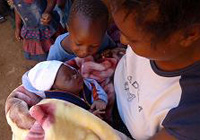Mirela Xanthaki
UNITED NATIONS, Nov 29 2009 (IPS) – While most HIV-positive people in the Western world can gain decades of good health thanks to increasingly effective drug regimens, in the developing world, nearly a third of children born with HIV are still dying before their first birthday.

Maureen Sakala participates in a programme that provides HIV medications to both her and her son Christopher, and will first test him for HIV when he is six weeks old. Credit: UNICEF
Half will die before their second birthday, and an overwhelming three-quarters do not make it to age five, according to the latest U.N. figures.
At a recent panel discussion on children with HIV hosted by the United Nations children s agency UNICEF as part of the 20th anniversary of the Convention on the Rights of the Child, activists and public health experts stressed the need for accessibility, appropriate testing and follow-up care.
UNICEF s Fourth Stocktaking Report on Children with AIDS, to be released Nov. 30, notes that progress that has been made for example, 45 percent of mothers with HIV now receive antiretroviral (ARV) drugs during pregnancy, compared to a scant 10 percent in 2004.
Yet the mother-to-child transmission rate is still about 80 percent in the developing world, compared to one to two percent in developed countries.
Critical steps include simple, affordable, on-the-spot diagnostic tests for infants; increased antiretroviral treatment for all HIV-positive expectant mothers; and greater efforts by pharmaceutical companies and governments to find more appropriate and accessible treatments for children and infants.
Related IPS Articles
There must be ongoing pressure on drug companies to adapt drugs for use in children, where possible, and make them more affordable, experts said.
HIV treatment has been available only since the mid-1990s, so we only have 12 to 13 years of experience, Dr. Shaffiq Essajee, director of clinical operations and senior advisor in pediatrics for the Clinton Foundation, told IPS.
People with HIV have [stayed] alive and grown healthy during this period. The sky is the limit in how long a child with HIV can live if it receives treatment, he stressed.
Children s immune systems react faster and more effectively to antiretroviral treatment than adults. The problem is the lack of affordable, child-friendly ARV formulations and how to make this possible in resource-limited settings, Essajee continued.
In 2004, the cheapest treatment cost 600 dollars for one child per year. Just two years later, the cost had fallen to 60 dollars. Cheaper drugs are a necessity but they don t solve the problem by themselves, experts note.
While parity has been achieved, we can t rest on our laurels, Essajee said.
There is still need for development of faster and more efficient early infant diagnosis and testing systems, he explained. There is a huge systemic problem because we are losing over half of the kids from the initial positive test to a treatment process. A third of children tested positive never make it to therapy.
Altogether, two million children are currently living with HIV, around seven percent of the global total.
Dr. Deborah Birx, director of the Global AIDS Programme at the U.S. Centers for Disease Control and Prevention, agreed. We fall short in the return of the results, she said. It might take from one to up to four months. In this gap, many parents don t even come back for the results.
They go one time to the clinic, but they don t have the money for another bus ticket to go again, said Father Ed Phillips, CEO and chair of the Eastern Deanery AIDS Relief Programme in Nairobi, Kenya.
The solution is more portable, easier to handle diagnostic systems that can process the sample while the parent waits, he and others said.
Women also have to be counseled so that they realise that they need to get tested. We can t access children if we can t access their mothers, Birx said. HIV testing and counseling is critical to preventing mother-to-child transmission of the disease.
Karen Plater, an associate secretary of the Presbyterian Church in Canada, told IPS there have been great improvements in many people s lives over the past years.
I visited Malawi for the first time in 1997. At the time there was no access to ART and people were still in denial, refusing to accept that it was a problem in their community, she said.
When I went again in 2001-2002, I saw a remarkable difference. People were talking about it more willingly. As the percentages of HIV people increased, everyone knew somebody directly or in their immediate family. It made them want to go to voluntary counseling and testing,
There was sense of hope, Plater stressed. The stigma is less than it was and HIV support groups right now entail healthy individuals, working together on projects, planting fields, trying to support one another.
The Ecumenical Advocacy Alliance, a broad international network of churches and Christian organisations cooperating on the issues of food and HIV/AIDS, started the Prescription for Life Campaign where children from 14 different countries were asked to write letters to executives of pharmaceutical companies and government officials asking for action.
An exhibition featuring excerpts from their pleas was launched this month at the United Nations Headquarters in New York and will be on display through Dec. 4.
Eric Sawyer, civil society partnerships advisor for UNAIDS and founder of Act Up New York and Housing Works, who has lived with HIV for nearly 30 years, said at the opening: Is that moral justice that I can buy nearly three decades of life and hopefully even more because I have access to the latest medications as soon as they re developed?
I don t think it s moral. I don t think it s just. I don t think it s right, he said. Everyone must be able to buy life like I have.